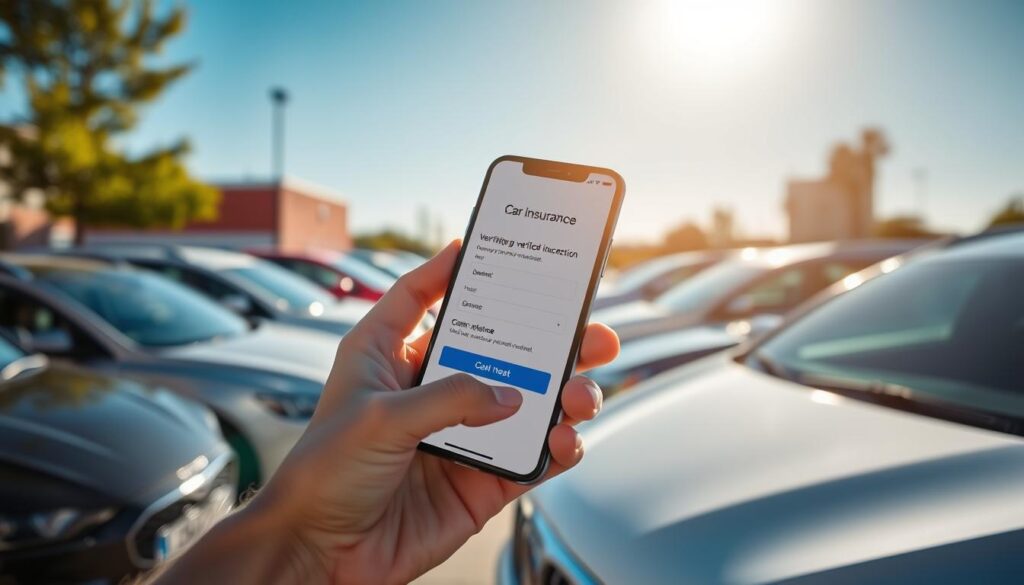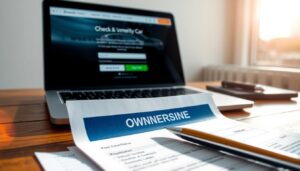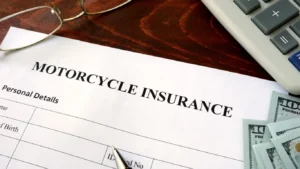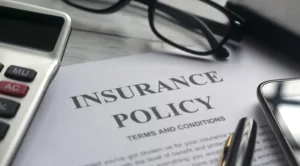Understanding car insurance can be tough. But, knowing if a car is insured is key. This is true when buying a used car, getting pulled over, or checking if a driver is covered. In this guide, we’ll show you how to quickly find out if a car has insurance. This will help you stay safe and informed on the road.

Key Takeaways
- Verifying car insurance is vital to avoid legal and financial issues.
- Use online tools and databases from states and third-party services to check insurance status.
- Contact the insurance company directly to confirm a vehicle’s policy details.
- Look for proof of insurance, like cards or policy documents.
- Know how to check insurance during a traffic stop or before buying a used car.
Understanding the Importance of Car Insurance
Car insurance is key for anyone who owns a vehicle. It’s not just a law in most places. It also helps you avoid big financial losses from accidents. Checking a car’s insurance is vital for keeping your money safe and being ready for any road issue.
Why You Need to Verify Insurance Coverage
Driving without insurance can lead to big problems. It’s crucial to check a car’s insurance before driving it. This helps avoid legal trouble and big money losses.
- Most states require you to have car insurance. Driving without it can lead to fines, losing your license, or even jail time.
- Insurance covers damage, medical bills, and liability in accidents. Without it, you might have to pay these costs yourself.
- Having insurance makes you feel safer and more confident while driving. It lets you focus on the road.
Consequences of Driving Without Insurance
Driving without insurance can lead to serious issues. Some of these include:
- Fines can be very high, from a few hundred to thousands of dollars.
- Your driver’s license might be taken away until you show proof of insurance. This can really mess up your day.
- If you’re in an accident without insurance, you’ll have to pay for damages and injuries yourself. This can cost a lot of money.
- When you get insurance again, your rates might go up. This is because you’ve been seen as a higher risk by the insurance company.
Checking a car’s insurance is very important. It keeps you legal, protects your money, and makes driving safer. Knowing why car insurance is important helps you make smart choices and keep everyone safe on the road.
How to Check if a Car Has Insurance
It’s important to know if a car is insured. This is for both legal and practical reasons. There are several ways to check if a car has insurance. We’ll look at these methods to make sure a car is insured.
Online Insurance Verification Tools
Online tools are a simple way to check a car’s insurance. State DMVs and insurance companies offer web services. You can enter a car’s details to see if it’s insured. These tools are great when buying a used car or if you think a car might not be insured.
Contacting the Insurance Company Directly
You can also call the insurance company. If you know the insurance provider, call their customer service. Give them the car’s license plate or VIN. They can tell you if the car is insured and what coverage it has.
Checking for Proof of Insurance Documentation
Looking for physical proof of insurance is another way. Check for an insurance card in the car. It should show the policy number, provider, and coverage dates.
Using these methods, you can be sure a car is insured. This means you’re driving legally and financially protected.
| Method | Description |
|---|---|
| Online Insurance Verification Tools | Web-based services provided by state DMVs and insurance companies that allow you to check a vehicle’s insurance status by entering its information. |
| Contacting the Insurance Company Directly | Calling the insurance provider and providing the vehicle’s details, such as the license plate or VIN, to confirm the insurance coverage. |
| Checking for Proof of Insurance Documentation | Examining the vehicle for a current insurance card or other documentation that displays the policy information and coverage dates. |
Online Insurance Verification Tools
Checking if a car is insured has gotten easier with online tools. These tools, from government agencies and third-party providers, let you check a car’s insurance by its license plate or VIN. Just enter the details, and you’ll know if the car is insured.
State-Provided Insurance Databases
Many states have their own online databases for insurance checks. These databases give you up-to-date info on a vehicle’s insurance status. Just type in the license plate or VIN to see if the car is insured.
Third-Party Insurance Checkers
There are also third-party tools for checking insurance. These services collect data from different places to give you a full insurance check. They might not be as official as state databases, but they’re still useful for quick checks.
| Tool | Type | Key Features |
|---|---|---|
| MyCarfax.com | Third-Party | Free vehicle history reports, including insurance status checks |
| DMV.org | Third-Party | Comprehensive vehicle information, including insurance verification |
| State DMV Websites | Government | Official state-run databases for insurance and vehicle registration verification |
Using a state or third-party tool can help make sure a car is insured before you buy or drive it. These tools are handy for checking insurance status quickly and easily.
Contacting the Insurance Company Directly
If you need to check a vehicle’s insurance status with the provider, you’ll need certain details. This guide will help you through the steps and what information you’ll need to give.
Information You’ll Need to Provide
To verify a vehicle’s insurance, you’ll need to give the insurance company some key information:
- The vehicle’s registration details, including the license plate number and vehicle identification number (VIN)
- The name of the policyholder or the person insuring the vehicle
- The insurance policy number, if available
- The effective dates of the insurance policy
Having this info ready will help the insurance company find the policy fast. They can then confirm if the vehicle is insured. Be ready to give more details if they ask to finish the check.
| Information Needed | Details |
|---|---|
| Vehicle Registration | License plate number, VIN |
| Policyholder Information | Name, policy number |
| Policy Effective Dates | Start and end dates |
By giving the insurance company the contacting insurance company and information needed to verify insurance, they can quickly find the policy details. They can then confirm if the vehicle is covered.

Checking for Proof of Insurance Documentation
Looking at the physical proof of insurance can give you important information. The insurance card or declaration page shows if a car is insured and if the coverage is active.
Here are some steps to follow when checking for proof of insurance and verifying insurance documents:
- Look for the insurance card or declaration page: This should be easy to find in the vehicle or given by the driver when asked.
- Check the policy details: Make sure the card or declaration page matches the car and driver. Look for the VIN, policyholder’s name, and policy dates.
- Verify the insurance company: Make sure the company listed is real and allowed to operate in your state.
- Ensure the coverage meets the minimum requirements: Check the policy limits and types to see if they meet your state’s laws.
By carefully examining the proof of insurance documentation, you can be sure the vehicle is insured and the coverage is valid.
“Verifying insurance coverage is a crucial step in ensuring the safety and legality of the road. Take the time to thoroughly check the documentation and protect yourself from potential legal and financial risks.”
Vehicle Insurance Lookup
Checking a car’s insurance status is very important. You need the vehicle identification number (VIN) for this. Knowing how to use a VIN helps you see if a car is insured.
Understanding Vehicle Identification Numbers (VINs)
A VIN is a 17-character code that makes a car unique. It tells you about the car’s maker, model, and year. By learning about VINs, you can check for vehicle insurance lookup and make sure the car is covered.
VINs are found in several places. Look on the dashboard, door jamb, or engine block. They’re also on the car’s registration and title. Knowing where to find a VIN helps you check a car’s insurance.
| VIN Breakdown | Example |
|---|---|
| World Manufacturer Identifier (WMI) | 1FT |
| Vehicle Description Section (VDS) | 7W2X6 |
| Vehicle Identifier Section (VIS) | 23456 |
Understanding a VIN’s parts gives you key info about a car. This includes its insurance lookup status. With this info, you can verify the insurance coverage before buying or driving a car.

Confirming Insurance Coverage during a Traffic Stop
If you’re pulled over, you must show the vehicle has valid insurance. This is easy but knowing the steps is key for a smooth talk with the officer.
When asked for your insurance info, be ready to share:
- Your current insurance policy number
- The name of your insurance provider
- The effective dates of your insurance coverage
Have this info ready, either in your glove box or on your phone. This makes checking your insurance quick and easy. Being prepared helps you confirm your insurance coverage during the traffic stop and prevents problems.
| Information Needed | Why It’s Important |
|---|---|
| Insurance Policy Number | This unique identifier allows the officer to quickly look up your policy and verify its validity. |
| Insurance Provider | The officer can use this information to contact your insurance company directly, if necessary, to verify insurance with law enforcement. |
| Effective Dates | Confirming the active dates of your insurance coverage ensures that you are compliant with state laws at the time of the traffic stop. |
Being ready and sharing the right info lets you confirm your insurance coverage during the traffic stop. This way, you avoid any legal trouble or complications.
Validating Insurance Before Purchasing a Used Car
When looking for a used car, it’s key to check if it’s insured before buying. This step helps you avoid legal and financial troubles later on.
To start, ask the current owner for proof of insurance. This should show the policy number, what’s covered, and when it ends. Make sure the policy is current and valid.
You can also call the insurance company yourself. Give them the car’s VIN or license plate number. They can tell you if the car is insured and if the policy is still good.
- Request proof of insurance from the current owner
- Contact the insurance company directly with the VIN or license plate
- Verify the policy details, such as coverage, expiration date, and any claims history
Checking the insurance of a used car before you buy is very important. By doing this, you make a smart choice and avoid surprises later.
“Purchasing a used car without verifying its insurance coverage can be a costly mistake. Take the time to check the insurance status upfront to avoid potential legal and financial headaches.”
How to Check if a Car Has Insurance: Additional Tips
Checking a car’s insurance is key, whether buying a used car or checking state laws. The main methods are good, but there are more ways to check insurance. These tips can make your process better.
Use online tools beyond the usual insurance sites. State DMV websites and services like Carfax and AutoCheck give detailed reports. They include insurance info, accident history, and more.
Don’t just check with one insurance company. Talk to several to get a full view of the car’s insurance history.
Remember, continuous insurance is vital. Gaps in coverage can lead to big problems. So, check for any breaks in the car’s insurance record.
- Utilize online vehicle history reports for additional insurance details
- Contact multiple insurance providers to cross-reference coverage information
- Prioritize continuous insurance coverage and investigate any gaps
By using these additional tips for checking car insurance and more ways to verify vehicle insurance, you’ll understand a car’s insurance better. This helps you make smart choices when buying or driving a car.
The Consequences of Driving Without Valid Insurance
Driving without insurance can lead to serious legal and financial issues. If you drive without coverage, you face penalties, fines, and other serious consequences. It’s important to know these risks to stay safe on the road.
Legal Penalties for Uninsured Driving
In most states, driving without insurance is a crime. The penalties can vary, but you might face:
- Fines from hundreds to thousands of dollars, based on the state and if it’s your first time.
- License suspension or revocation, making it hard to get to work or run errands.
- Vehicle impoundment, leaving you without a car and facing extra fees to get it back.
- Possible jail time, especially for repeat offenders or those in accidents without insurance.
Financial Risks of Driving Without Insurance
The financial damage of driving without insurance can be huge. If you’re in an accident, you’ll have to pay for damages and injuries to others. This can cost tens or hundreds of thousands of dollars. Without insurance, you’ll have to pay out of pocket, leading to financial trouble, bankruptcy, and even losing your assets.
| Consequence | Description |
|---|---|
| Fines | Ranging from hundreds to thousands of dollars, depending on the state and whether it’s your first offense. |
| License Suspension | Your driver’s license may be suspended or revoked, making it difficult to get to work or run errands. |
| Vehicle Impoundment | Your vehicle may be impounded, leaving you without transportation and potentially incurring additional fees to retrieve it. |
| Jail Time | In some cases, particularly for repeat offenses or when an uninsured driver is involved in an accident, you may face jail time. |
| Financial Liability | If you’re involved in an accident, you’ll be responsible for paying for any damages and injuries to the other party, which can easily run into the tens or hundreds of thousands of dollars. |
The effects of driving without insurance can be severe and long-lasting. Having the right coverage protects you, your finances, and others on the road. It’s not worth the risk to drive without insurance.
Conclusion
Throughout this guide, you’ve learned how to check if a car has insurance. You can use online tools, contact insurance companies, and look for proof of insurance. This ensures you follow the law and stay safe on the road.
To verify vehicle coverage, use state databases, third-party checkers, and contact the insurance company. Also, be ready to show proof of insurance during stops and when buying a used car.
Confirming a car’s insurance status is both legal and smart. It protects you and others. By following this guide, you’ll know you’re covered and ready for anything.
FAQ
How can I check if a car has insurance?
You can check if a car has insurance in a few ways. You can use online tools, call the insurance company, or look at the car’s insurance documents.
What information do I need to check a car’s insurance status?
To check a car’s insurance, you’ll need its registration details. This includes the license plate number or Vehicle Identification Number (VIN).
What are the consequences of driving without insurance?
Driving without insurance can lead to big problems. You might face fines, lose your license, or even get arrested.
How can I check a car’s insurance status during a traffic stop?
At a traffic stop, show you have insurance for the car. You can call the insurance company or show your insurance documents.
How do I validate a car’s insurance coverage before purchasing a used vehicle?
Before buying a used car, check its insurance. Use online databases, call the insurance company, or ask for the current documents.
What are some additional tips for checking if a car has insurance?
For more tips, use different online tools and call various insurance companies. Also, remember to keep your insurance coverage continuous to avoid gaps.






